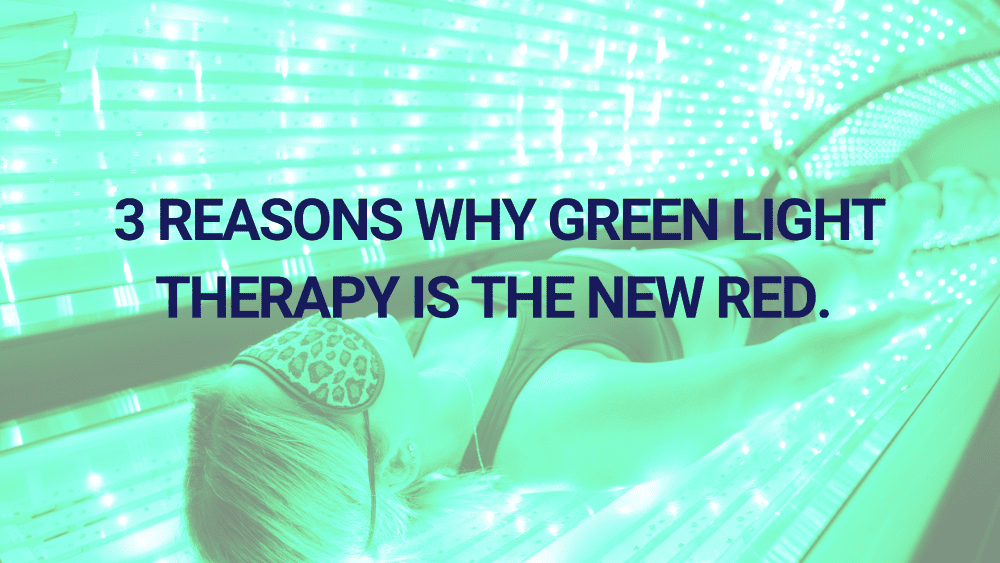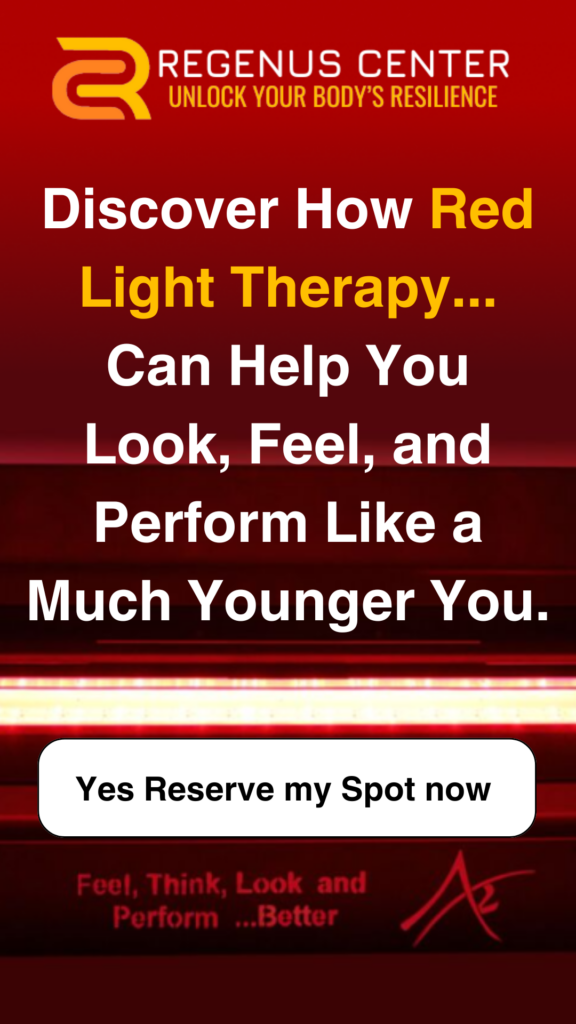Here are three reasons green light therapy is considered the new red light therapy.
Now does it replace red or infrared light therapy? No, it’s just on par, with a whole set of benefits for those who experience it; plus, when mixed with infrared, additional benefits are seen below.
Photobiomodulation (changing the body with light) groups are now saying, “Green is the new Red” because green light therapy, surprisingly, is outperforming red light therapy in a number of recent studies. REGENUS CENTER has been incorporating Green Light into its protocol since 2018.
When most people think of light therapy, they would probably immediately default to SAD Seasonal Affective Disorder. So let’s start there.
In this study, which by the way, dates back to 1991, on seasonal affective disorder… here was the conclusion:
Green light provides a treatment effect superior to red light and similar to that seen in previous studies with white light. These results are consistent with the hypothesis that retinal photoreceptors mediate the antidepressant response in seasonal affective disorder. Identifying optimal wavelengths for light treatment is important in optimizing phototherapy efficacy.
I highlight the last sentence because the manufacturer we use for our light beds here at Regenus Center is known for optimizing phototherapy and dose and has been carrying green, unlike most whole-body photobiomodulation providers, in addition to red and infrared since 2015.
That conclusion was corroborated by the National Institutes of Health
Ok, now, three reasons outside of Seasonal Affective Disorder.
Green Light:
- 528 nm is absorbed into the heme and oxyhemoglobin, supercharging the blood.
- Research shows green is more effective than Red in treating wound and skin applications.
- Green Light Helps Pain – Green light appears to have two mild pain-relieving effects: it is antinociceptive (analgesic, meaning a pain reliever) and antihyperalgesic (reduces sensitivity to input from the nervous system).
Green LEDs promote wound healing by inducing migratory and proliferative mediators, which suggests that not only red LEDs but also green LEDs can be a new powerful therapeutic strategy for wound healing and pain relief through a different pathway than red/NIR as well as being effective for migraines.
Recent research has shown that green activates a new pathway for pain release. This suggests further that combining green and red/infrared might be a more powerful tool for pain than traditional Red/NIR therapy devices.
We believe that green will also prove to be antibacterial and antiviral. ARRC LED has used multiple green, red, and near-infrared wavelengths since 2015 with our first devices.
Other effects of green light therapy on the body include:
- Resetting the circadian rhythm: photoreceptors in the eye are extremely sensitive to types of light, and when these photoreceptors are exposed to green light, it alters melatonin production to stimulate energy and alertness (perception of pain is often reduced when we are energized).
- Green light therapy alters serotonin levels and stimulates the endogenous opioid system (the body’s pain-relieving system present in the central and peripheral nervous systems, the immune system, and the gastrointestinal tract).
- Green light therapy increases the number of pain-relieving molecules known as enkephalins.
- Green LED light stimulates the endogenous endorphin and cannabinoid systems—the body’s own naturally produced painkillers. A follow-up human study to the animal study mentioned above is underway, but to date, there is just not enough data to confirm whether green light therapy for pain is as effective as red light therapy.
Green light therapy for migraines
Dr. Rami Burstein found that a special narrow band (520nm +/-10) of green light can help people who suffer from migraines by producing smaller electrical signals in the eyes and brain. This precise band of light’s soothing glow can help them get back to their everyday lives, but interestingly any light outside of that band can actually diminish or even negate the effects.
You can learn more about that here.
We urge you to beware of companies purporting to treat pigmentation with green light wavelengths. Most claims of green light’s effectiveness have been shown, via scientific research, to be achievable by red + near-infrared, which have the capability to reach the target cells located deeper in the tissue.
However, as a science-based company, we understand that new evidence is published all the time. If you have any credible scientific evidence to support otherwise, please pass it along!
Highlighting New Green Light Therapy Research
Research published in late 2020 shows green light exposure exhibiting promise in the treatment of chronic pain, specifically migraine headaches and the often-debilitating pain they can cause.
The paper, “Evaluation of green light exposure on headache frequency and quality of life in migraine patients: A preliminary one-way cross-over clinical trial,” was published online by Cephalalgia, the journal of the International Headache Society.
According to the Migraine Research Foundation, migraine headaches are the third most prevalent illness worldwide, impacting approximately 39 million people in the U.S., with crushing pain and loss of productivity.
Green Light Therapy Migraine Study
Researchers from the University of Arizona recruited 29 patients (seven with episodic migraine and 22 with chronic migraine headaches. The study “used a one-way cross-over design consisting of exposure for 1-2 hours daily to white light-emitting diodes for 10 weeks, followed by a 2-week washout period followed by exposure for 1-2 hours daily to green light emitting diodes for 10 weeks.
Patients were allowed to continue current therapies and to initiate new treatments as directed by their physicians. Outcomes consisted of patient-reported surveys. The primary outcome measure was the number of headache days per month.
Secondary outcome measures included patient-reported changes in the intensity and frequency of the headaches over a two-week period and other quality-of-life measures, including the ability to fall and stay asleep and the ability to perform work. Changes in pain medications were obtained to assess potential reduction.”
Promising Results for Migraine Pain Relief
The results were as follows: “When seven episodic migraine and 22 chronic migraine patients were analyzed as separate cohorts, white light emitting diodes produced no significant change in headache days in either episodic migraine or chronic migraine patients.
Combining data from the episodic migraine and chronic migraine groups showed that white light-emitting diodes produced a small but statistically significant reduction in headache days from (days ± SEM) 18.2 ∓ 1.8 to 16.5 ∓ 2.01 days.
Green light-emitting diodes significantly decreased headache days from 7.9 ∓ 1.6 to 2.4 ∓ 1.1 and from 22.3 ∓ 1.2 to 9.4 ∓ 1.6 in episodic migraine and chronic migraine patients, respectively.
While some improvement in secondary outcomes was observed with white light-emitting diodes, more secondary outcomes with significantly greater magnitude, including assessments of the quality of life, Short-Form McGill Pain Questionnaire, Headache Impact Test-6, and Five-level version of the EuroQol five-dimensional survey without reported side effects were observed with green light emitting diodes.
Conclusions regarding pain medication reduction with green light emitting diode exposure were impossible. No side effects of light therapy were reported. None of the patients in the study reported initiation of new therapies.”
REGENUS CENTER, given there are no side effects of using Green Light Therapy, just based on its initial findings and the fact that it’s part of the light spectrum for a reason, is useful in a therapeutic setting, and new research is coming out each day; all promising.
Important References
https://www.celluma.com/blogs/blog/green-led-light-therapy-how-effective-is-it
1. Light-Emitting Diodes (LEDs) in Dermatology Daniel Barolet, MD, FRCPC, Department of Medicine, Dermatology Division, McGill University, Montreal, Quebec, Canada.






